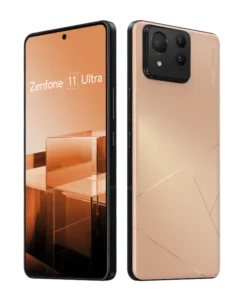The arrival of the Zenfone 11 Ultra has exceeded our expectations, particularly with its notably larger size, a departure from the compact flagships we’ve come to associate with the Zenfone line. Unboxing this device revealed a 6.78-inch display, a significant increase from its predecessor, the Zenfone 10. Amid rumors suggesting changes in the Zenfone lineup, Asus clarified its commitment to both the ROG Phone and Zenfone series, leaving us to ponder the implications of this “Ultra” addition. Will there be room for a non-Ultra compact Zenfone in the future, or is this the end of compact designs? Only time will tell. Nonetheless, the Zenfone family has a history of innovation, evident in past features like the flip-up camera. Moving forward, possibilities abound.
In terms of specifications, the Zenfone 11 Ultra closely resembles the ROG Phone 8, boasting a larger display and a robust 5,500mAh battery. Its generous internal space accommodates an impressive camera setup and facilitates efficient cooling for the Snapdragon 8 Gen 3 chipset, unlike the constraints of previous compact designs. Packaged in an eco-friendly beige-colored box, the Zenfone 11 Ultra reflects Asus’s commitment to sustainability, with a reduction in paper usage and improved packaging efficiency. However, the absence of a charger is notable, although the included cable’s specifications may limit charging speed. Testing will determine if this poses a significant inconvenience. Additionally, the inclusion of a bumper case made from recycled materials adds a thoughtful touch to the overall package.
In-Depth Technical Details Of Asus Zenfone 11 Ultra

| Feature | Specification |
|---|---|
| Body | 163.8×76.8×8.9mm, 224g; aluminum frame, glass front and back; IP68 dust/water resistant. |
| Network | 2G, 3G, 4G, and 5G. |
| Display | 6.78″ LTPO AMOLED, 144Hz, 1600nits (HBM), 2500nits (peak), 1080x2400px resolution, 20:9 aspect ratio, 388ppi; Always-on display. |
| Chipset | Qualcomm Snapdragon 8 Gen 3 (4nm). |
| Memory | 256GB 12GB RAM, 512GB 16GB RAM. |
| OS | Android 14 (1st Release). |
| WLAN | Wi-Fi 802.11 a/b/g/n/ac/6e/7. |
| Bluetooth | v5.3. |
| Rear camera | Wide (main): 50MP; Ultra-wide: 13MP; Telephoto: 32MP, 3x optical zoom. |
| Front camera | 32MP. |
| Battery | 5500mAh; 65W wired, 15W wireless, 10W reverse wired. |
| Others | Fingerprint reader (under display); NFC; stereo speakers; 3.5mm jack. |
Conclusion
Our experience with the Zenfone 11 Ultra was undeniably enjoyable. Asus maintains a practical approach to smartphone development and user experience, particularly evident in the Zenfone series, aimed at appealing to a broad audience beyond just gaming enthusiasts. However, the Zenfone 11 Ultra leaves us with some lingering questions. We ponder whether this flagship represents the zenith of the Zenfone 11 lineup or if a more compact variant is in the pipeline. Asus remains tight-lipped on the subject, occasionally citing the Zenfone 10 as a viable compact alternative for the foreseeable future. Let’s address the elephant in the room without sugarcoating it. While the availability of a compact device is appreciated, the reality is that the market trend favors larger displays. Releasing a 6.78-inch device aligns with this trend and is likely a strategic move by Asus. It’s noteworthy, albeit peculiar, that the Zenfone 11 Ultra now competes with its own ROG Phone 8 Pro counterpart in certain aspects. Nevertheless, in the current market landscape, a larger Zenfone appears to be the logical choice. Regarding the Zenfone 11 Ultra’s product merits, there are minimal flaws to criticize. The absence of a charger in the retail package and potential cooling issues with the powerful Snapdragon 8 Gen 3 processor are the only minor setbacks. Otherwise, the Zenfone 11 Ultra impresses across the board, standing shoulder to shoulder with the top-tier premium smartphones. We anticipate its success in the market and hope it elevates Asus’s standing and popularity among consumers.
